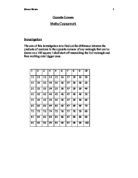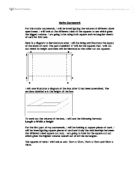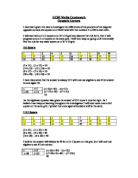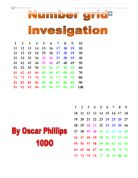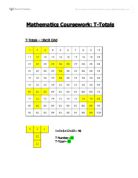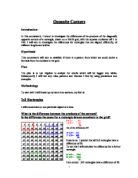T-total coursework
Part 1 Investigate the relationship between the T-total and the T-number 2 3 4 5 6 7 8 9 0 1 2 3 4 5 6 7 8 9 20 21 22 23 24 25 26 27 28 29 30 31 32 33 34 35 36 37 38 39 40 41 42 43 44 45 46 47 48 49 50 51 52 53 54 55 56 57 58 59 60 61 62 63 64 65 66 67 68 69 70 71 72 73 74 75 76 77 78 79 80 81 2 3 0 1 2 9 20 21 The T-number is always the number at the bottom of the T, so in this case (the yellow T) it is 20. The sum of all the numbers in the T is the T-total. In this case, the T-number, (which will now be called n) is 20, and the T-total, (which will now be called T) is 37. If the number at the bottom of the T is n, these are the other numbers in terms of n, bearing in mind that the width of the grid is 9 (by 9): n-19 n-18 n-17 0 n-9 2 9 n 21 The number above the T-number is (n-9) because this number is exactly one row above (n). The width of the grid is 9, so by moving up 1 cell from (n), I am decreasing the value by the width of the grid (9). The cell above (n-9) is (n-18) as the value has been decreased by the width of the grid again. The cell to the left of (n-18) is (n-19) as it has been decreased by 1. The cell to the right of (n-18) is (n-17) as it is 1 more than (n-18). When these 5 terms are added together I get: (n) + (n-9) + (n-17) + (n-18) + (n-19) = 5n - 63
Gradient Function
Gradient Function Introduction For this project, I will deduce the gradient for several y=axn graphs and with this find any sort of relationships between the x values and the gradient. A gradient is the steepness of a curve at a point. Gradients can prove to be very useful. It usually means something in most graphs for e.g. in distance-time graphs, the gradient indicates the speed. The gradient formula for a straight line is: Gradient = Change in y Change in x However, since the y=axn forms a curve rather than a simple straight line, it is much more apprehensive to calculate its gradient. Therefore, another method has to be applied. The gradient for the non-linear graph is the steepness of a curve at one particular point. In order to find this, I will need to draw specific tangents on different x-axis points. A tangent in a non-linear graph is a straight line that essentially touches the curve at one point with two tiny alike angles either side. It must not touch more than one particular point or intersect the curve, as this will distort the outcome. As a result, we can say that the curve's steepness at a particular point is identical to the tangent formed in that specific curve. I will draw four graphs: y=x2, y=x3 y=2x2 and y=x-1. From each of these graphs I will infer different gradients and compare my results with the theoretical result that is found by using the
Opposite Corners
Opposite Corners Maths Coursework Investigation The aim of this investigation is to find out the difference between the products of numbers in the opposite corners of any rectangle that can be drawn on a 100 square. I shall start off researching the 2x3 rectangle and then working onto bigger ones. 2 3 4 5 6 7 8 9 0 1 2 3 4 5 6 7 8 9 20 21 22 23 24 25 26 27 28 29 30 31 32 33 34 35 36 37 38 39 40 41 42 43 44 45 46 47 48 49 50 51 52 53 54 55 56 57 58 59 60 61 62 63 64 65 66 67 68 69 70 71 72 73 74 75 76 77 78 79 80 81 82 83 84 85 86 87 88 89 90 91 92 93 94 95 96 97 98 99 00 2x3 Rectangle 7 8 9 7 8 9 2 3 1 2 3 88 89 90 98 99 00 x13=13 88x100=8800 7x19=133 1x3=33 98x90=8820 17x9=153 20 20 20 Prediction I predict that when I multiply a 2x3 rectangle the opposite corners will have a difference of 20. 2x2 Rectangle (square) 72 73 82 83 4 5 4 5 33 34 43 44 4x15=60 33x44=1452
opposite corners
Maths Coursework: Opposite Corners Opposite Corners: Introduction: My algebra coursework is about opposite corners in a square in a number grid. The top right and the bottom left numbers are multiplied and the same is done with the top left and bottom right numbers. The difference is calculated between the 2 products and the answer is used to find a pattern. The size of the square will be changed, 2x2, 3x3 and 4x4, to see whether the answers left will help to determine whether or not there is a pattern. 0x10 Grid: I am starting off by using a 10x10 and within this grid I will outline 2x2 squares, 3x3 squares and 4x4 squares. With these squares I will work out the opposite corners in order to see whether or not there is a pattern. 2 3 4 5 6 7 8 9 0 1 2 3 4 5 6 7 8 9 20 21 22 23 24 25 26 27 28 29 30 31 32 33 34 35 36 37 38 39 40 41 42 43 44 45 46 47 48 49 50 51 52 53 54 55 56 57 58 59 60 61 62 63 64 65 66 67 68 69 70 71 72 73 74 75 76 77 78 79 80 81 82 83 84 85 86 87 88 89 90 91 92 93 94 95 96 97 98 99 00 2x2 Squares: 2 3 4 5 6 7 8 9 0 1 2 3 4 5 6 7 8 9 20 21 22 23 24 25 26 27 28 29 30 31 32 33 34 35 36 37 38 39 40 41 42 43 44 45 46 47 48 49 50 51 52 53 54 55 56 57 58 59 60 61 62 63 64 65 66 67 68 69 70
Opposite Corners
Opposite corners 1 2 3 4 5 6 7 8 9 10 11 12 13 14 15 16 17 18 19 20 21 22 23 24 25 26 27 28 29 30 31 32 33 34 35 36 37 38 39 40 41 42 43 44 45 46 47 48 49 50 51 52 53 54 55 56 57 58 59 60 61 62 63 64 65 66 67 68 69 70 71 72 73 74 75 76 77 78 79 80 81 82 83 84 85 86 87 88 89 90 91 92 93 94 95 96 97 98 99 00 On a 10*10 square grid, choose any 2*2 square, multiply the corners in that grid and then find the difference between the two corners investigate. 2 13 12 13 16 17 16 17 22 23 * 23 * 22 26 27 * 27 * 26 276 284 332 342 284-276=10 342-332=10 Difference=10 The two answers are the same. I think it would be the same for any 2*2 square. To prove this I will use algebra to show that in any 2*2 square the difference will 10. z- number in the top left corner z z+1 z(z+11)=z²+11z z+10z+11 (z+1)(z+10)=z²+11z+10 (z²+11z+10)-(z²+11z)=10 Difference = 10 This proves that with any 2*2 square the corners multiplied then subtracted always = 10 To further my investigations I am now going to
Emmas Dilema
Emma's Dilemma In this investigation, we had to find out the number of different combinations that could be made when different amounts and combinations of letters were formed. This includes repeated patterns of letters. Emma and Lucy wanted to find the amount of different combinations each of their names could make. Emma can be represented by the letters AABC as there is the same amount of letters in both and there is one repeat in both as well. Lucy can be represented by ABCD as it contains 4 different letters with no repeats. I also had to attempt to find a formula to work out the amount of combinations for other amounts of letters. To find out the amount of combinations which can be made by non-repeated or repeated patterns of letters, I started off with a combination which contains the same letters, for example for a repeated pattern of letters AA, and then add letters to that, for example AAB then AABC etc. Combinations with no repeats: A: 1. A AB: 1. AB 2. BA ABC: 1. ABC 2. ACB 3. BAC 4. BCA 5. CAB 6. CBA ABCD: 1. ABCD 2. ABDC 3. ACBD 4. ACDB 5. ADCB 6. ADBC 7. BACD 8. BADC 9. BCAD 10. BCDA 11. BDAC 12. BDCA 13. CABD 14. CADB 15. CBAD 16. CBDA 17. CDAB 18. CDBA 19. DABC 20. DACB 21. DBAC 22. DBCA 23. DCAB 24. DCBA Here is a table of my results: Amount of letters in combination Amount of different combinations made by letters
Maths Coursework
Maths Coursework For this maths coursework, I will be investigating the volume of different sized open boxes. I will look at the different sizes of the squares to see which gives the biggest volume. I am going to be using both square and rectangular sheets of card for this task. Here is a diagram to demonstrate what I will be doing and illustrate the layout of the sheet of card. The parts labelled 'x' will be the squares that I will cut out which its height and sizes will be identical as the other cut out squares. x x x x x x x x I will now illustrate a diagram of the box after it has been assembled. The sections labelled x is the height of the box. To work out the volume of the box, I will use the following formula: Length x Width x Height For the first part of my coursework, I will be looking at square pieces of card. I will be investigating square pieces of card and study the relationships between the different sized square cut outs. I am going to look for the square cut out which gives the highest volume overall out of all the rectangles. The squares of sizes I will look at are: 12cm x 12cm, 15cm x 15cm and 18cm x 18cm. The first square I will look at
Mathematics Coursework: problem solving tasks
My name is.....................; I am currently attending the ................ Amongst the various subjects I am undertaking this year, is GCSE mathematics. My coursework assignment asks that I seek to stipulate a formula that will help me establish exactly the required amount of spacers necessary for different arrangements of tiles. I feel the use of diagrams will be useful to depict different arrangements of tiles. Only from these arrangements, will I then be able to collect related information which will then assist me to compile a set of results. Subsequently; I will then organize my results systematically in table form and hopefully from this table I will become aware of a pattern beginning to form. Once I recognize this pattern, I can then determine a suitable formula as a way to work out the required amount of spacers needed for each tile arrangement without having to draw out all diagrams manually. A formula is a rule written in symbols and letters. Spacers are used when tiling a wall, to make sure the tiles are evenly spaced in straight lines, and that the grout between the tiles is of even thickness. Three types of spacers are used when tiling a wall, these include; * T spacer * + spacers & * L spacers My Prediction 'The L shape spacers required for each tile arrangement will always be 4' Results Table I made a table to show my results in a clear way
To find a relationship between the opposite corners in various shapes and sizes.
Gemma McCormick Opposite Corners Aim: - To find a relationship between the opposite corners in various shapes and sizes. First I am going to draw a square that will be 10 squares in depth and 10 squares in width. I am the going to number the squares 1 to 100, 1 in the top corner and 100 in the bottom square. I will then draw a series of two by two squares inside my main grid. The aim being to find out a relationship between the opposite corners inside the small boxes. Ten by Ten (2x2) 2 3 4 5 6 7 8 9 0 1 2 3 4 5 6 7 8 9 20 21 22 23 24 25 26 27 28 29 30 31 32 33 34 35 36 37 38 39 40 41 42 43 44 45 46 47 48 49 50 51 52 53 54 55 56 57 58 59 60 61 62 63 64 65 66 67 68 69 70 71 72 73 74 75 76 77 78 79 80 81 82 83 84 85 86 87 88 89 90 91 92 93 94 95 96 97 98 99 00 I am now going to multiply the opposite corners in each box (Note the boxes are highlighted in red) Box 1 4 x 25 = 350 5 x 24 = 360 I am now going to look at the difference in each corner by subtracting my two answers. 350 - 360 = 10 The difference between the opposite corners was ten; I am now going to see if this is repeated. To do this I will repeat the process until my results show a constant pattern. 56 x 67 = 3752 57 x 66 = 3752 3762 - 3752 = 10 The difference again is 10, this would lead me to believe
Maths coursework- stair totals. I shall be investigating the total and difference in sets of stairs in different grid sizes. I will be investigating the relationship between stair totals on different grids.
GCSE Mathematics Coursework Introduction In my mathematics GCSE coursework I shall be investigating the total and difference in sets of stairs in different grid sizes. I will be investigating the relationship between stair totals on different grids. This will also include different stair sizes. I will choose to display my findings using a mixture of graphs, tables and grids. I shall also try to work out the formula for each of the number of step sizes. After I have finished investigating the different sized number stairs I will attempt to find out the different sized number grids. At the end of my investigation I will conclude by demonstrating and explaining the relationship between all sizes of stairs. Method I shall be carrying out my stair challenge by finding out the correct information. I shall do this by experimenting with the size of the grid corresponding to the size of the stairs used in the grid. I shall try to work out the formulas by recognising any similarities in the results obtained. Part 1- Three Step grid I have investigated the three step stair (some of my findings can be viewed on the graph paper in the back). During my investigation I believe that I have worked out the formula for the total inside the three step stairs on a 10 x 10 grid. Below is an example of just one of the three sets of stairs that I used to conduct my






